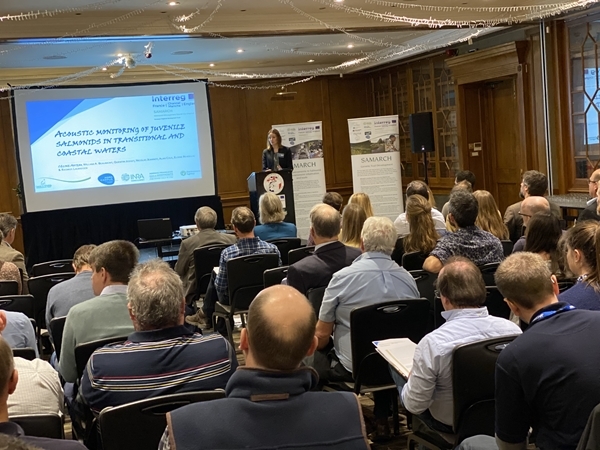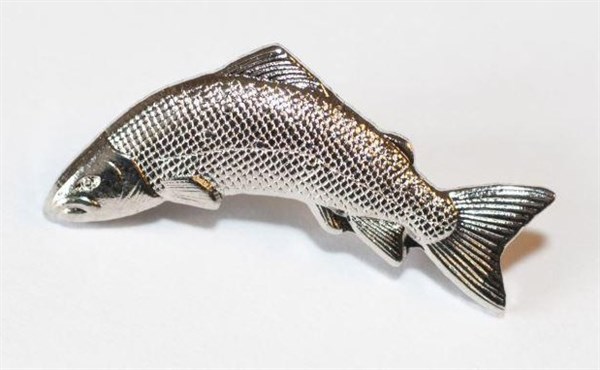
GWCT's Celine Artero leads a talk at the conference. Picture Olly Dean.
SCIENTISTS and fishery managers involved in studying salmon and sea trout at sea shared their ideas, knowledge and expertise at an international conference in Southampton this week.
The two-day event, organised by the Game & Wildlife Conservation Trust (GWCT), Salmon and Trout and Conservation Trust – whose chief executive Paul Knight acted as chairperson - and Atlantic Salmon Trust, saw guests exchange research ideas for possible future collaborations through a range of different sessions.
Numbers of salmon and sea trout returning to our rivers have declined by 70% over the last 30 years and evidence suggest that much of the problem is at sea. Particularly from climate change, affecting food quantity, its location and quality, overfishing of salmon’s marine food sources and their accidental capture in fishing trawlers and coastal nets.
Current or recent fish tracking projects and new and emerging fish tracking technology was the focus of day one, with talks ranging from acoustic monitoring of juvenile salmonids and environmental DNA analyses of Atlantic Salmon to autonomous ocean observing platforms and the behaviour and mortality of sea trout.
The attention of the second day, however, was on the analysis of tracking data and maximising the benefits of multiple tracking projects, with talks centring around long-term fish survival and electronic telemetry tagging.
The workshop was hosted on behalf of a multi-million-pound project, known as SAMARCH (SAlmonid MAnagement Round the CHannel).
The project, which started in 2017 and is running until 2022, has been tracking wild salmon and sea trout through four English and French estuaries to fill the gaps in our knowledge of how quickly these fish migrate through intertidal habitat, the dangers they face there and where they go once, they reach the sea.
It’s a cross-border five-year project which includes 10 partner organisations - five in France and five in the UK - with the GWCT the lead partner. The other partners include Institut National de Recherche Agronomique, Universities of Bournemouth, Exeter and Agrocampus Ouest, and Salmon & Trout Conservation, Environment Agency, Agence Française pour la Biodiversité, Normandie Grands Migrateurs and Bretagne Grands Migrateurs.
Funded by the EU’s Interreg VA France (Channel) England programme, the project has been using state-of-the-art fish monitoring facilities on five rivers to quantify the threats to salmon and sea trout in the south of England and northern France.
It has also been focusing on the behaviour and mortality of salmonid populations in estuaries and coastal waters to determine where losses are greatest.
SAMARCH project manager and head of fisheries at GWCT Dylan Roberts said: “The EU-funded SAMARCH project is progressing well and it was great to hear so many different viewpoints from experts at the conference.
“We were delighted to have speakers from nine different countries who are experts in tracking salmon at sea both in the Atlantic and Pacific. If we are to take a large step forward in our knowledge of what is happening to salmon at sea, then these events are crucial to forge closer collaboration, focus resources and expertise to develop joint new projects.”
“We have completed the collection of migration data from salmon and sea trout smolts from four rivers flowing into the Channel in spring 2018 and 2019.”
Dylan continued: “This data is currently being analysed, but preliminary results suggest that salmon have a slightly different strategy for exiting estuaries than sea trout, and survival through the lower river and estuaries in these two years was generally good. The project has also tagged 115 adult sea trout kelts on three rivers flowing into the Channel to monitor their movements and swimming depths at sea.”
“Preliminarily results suggest that the sea trout are swimming to depths of up to 50m. This contradicts much of the current strategy to protect sea trout at sea where gill nets for e.g. bass and mullet must be set at least 3m from the surface. Over the last three years, the project has tagged some 40,000 young salmon and 10,000 young trout to look at the marine survival of salmon and sea trout.”
To find out more about SAMARCH, visit https://samarch.org/

Get your GWCT Fisheries Badge for £9.99
£5 from the sale of each badge goes directly to our fisheries research centre in Dorset
You can help us understand what's driving the decline in Atlantic Salmon numbers by buying one of our salmon pewter pin badges. The badge measures approx. 3cm.
View Badge >
or
Buy Now - £9.99 >
100% Secure. All Credit & Debit cards, PayPal, Apple Pay and Google Pay accepted.

Notes to editors
The Game & Wildlife Conservation Trust – providing research-led conservation for a thriving countryside. The GWCT is an independent wildlife conservation charity which has carried out scientific research into Britain’s game and wildlife since the 1930s. We advise farmers and landowners on improving wildlife habitats. We employ more than 60 post-doctoral scientists and other research staff with expertise in areas such as birds, insects, mammals, farming, fish and statistics. We undertake our own research as well as projects funded by contract and grant-aid from government and private bodies.
For information, contact:
Eleanor Williams
Telephone: 07592 025476
Email: press@gwct.org.uk